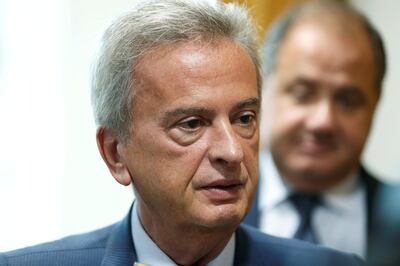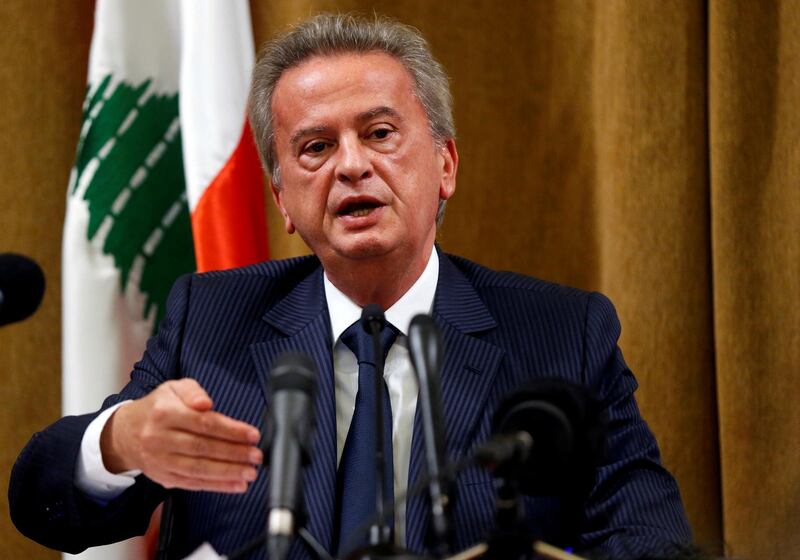Lebanon’s central bank governor Riad Salameh on Friday responded to accusations that he had inflated his institution’s assets by $6 billion in 2018, saying that the measures he took were “not meant to make its financial position seem stronger or to conceal losses.”
His actions, he said, were “in line with accounting policies approved by its board of directors”.
Mr Salameh’s response was published on the website of Lebanese television network LBCI a day after Reuters published a report claiming that Mr Salameh had balanced his books while helping to fund an ever-widening government deficit by recording a 10.27 trillion Lebanese pound ($6.82 bn / Dh25 bn) asset described as "seigniorage on financial stability".
The Financial Times broke the story on Tuesday, describing Mr Salameh's move as an "unorthodox accounting measure" to "swell the bank's assets and balance its books as risky liabilities grew".
The accounts were signed off with qualifications by EY and Deloitte last month and have not been made public, both Reuters and the FT reported.
Most central banks record seigniorage, usually defined as a profit made from printing money, as an income stream.
But Lebanon's central bank was recording expected seigniorage profits as an asset, according to the annual financial statement for 2018, prepared by the central bank and reviewed by EY and Deloitte.
"The item that deals with seigniorage is total fiction," Steve Hanke, Professor of Applied Economics at the Johns Hopkins University, told Reuters.
Two independent experts told the FT that they had never heard of such an accounting measure and said that the accounting measure “might be being erroneously used to obscure losses”.
Neither the BDL, Deloitte or EY responded to either publication.
Explaining why they were signing off on the accounts with qualifications, EY and Deloitte listed a number of factors including being unable to confirm all deposit balances and being unable to conduct an in-person inventory of the bank's gold reserves, Reuters reported.

In addition, Deloitte and EY said the central bank used an accounting and financial reporting framework adopted by its own council, rather than International Financial Reporting Standards (IFRS). They said their own audit was conducted in accordance with International Standards on Auditing.
The most recent central bank data show it had assets of $152 billion last month. According to research by Credit Libanais, that included "other assets" valued at $48.2 billion in mid-June, 61 per cent higher than a year before, a rise the investment bank attributed to seigniorage, open market operations and an appreciation in gold reserves.
The 2018 statements showed the central bank held gold worth 10.61 trillion pounds, although the auditors said they were unable to perform a physical inventory due to a "policy which gives access exclusivity to top executives of the bank".
Asked about the 2018 report, Alain Bifani, the second member of Lebanon's IMF team to quit last month, after 20 years as director general at the finance ministry, said auditors had not carried out a physical inspection of the central bank's gold reserves for years.
"As far as I know in the last 30 years they haven't been allowed to do an inventory of the gold reserves," he said.
"The most glaring thing is how they're hiding the losses. He is trying to inflate his assets as much as possible."
In his statement on Friday, Mr Salameh said that “many central banks resort to delaying costs to achieve their goals” and that for the past 15 years, the BDL had been operating under “exceptional circumstances”.
The BDL did not elaborate on these circumstances. In 2011, the Syrian civil war disrupted the Lebanese economy and caused the inflow of over 1 million refugees.
Mr Salameh also said that the central bank had to financially support the government which was “under pressure from increases in the wages of employees of the public sector and the economic consequences of the influx of Syrian refugees since 2011”.
Once revered as one of the best central bank governors in the world, Mr Salameh, who has held his job since 1993, has been the object of public anger since Lebanon’s economic meltdown began last summer.
In April, Mr Salameh gave a rare televised speech to defend his record after being publicly accused by Prime Minister Hassan Diab of failing to take action to stop the crisis.
He complained that there was a co-ordinated campaign against him, arguing that the bank’s role was to finance the state but that ultimately, politicians controlled how it was spent. The bank’s “accounting systems are not hidden from anyone,” he said at the time.
On Tuesday, the government agreed to hire turnaround specialist Alvarez & Marsal to conduct a forensic audit of the central bank as it grapples with a financial meltdown.
Prime Minister Hassan Diab told cabinet the audit would “represent a drastic transformation on the path to uncovering what happened at the financial level in terms of waste and theft”.







